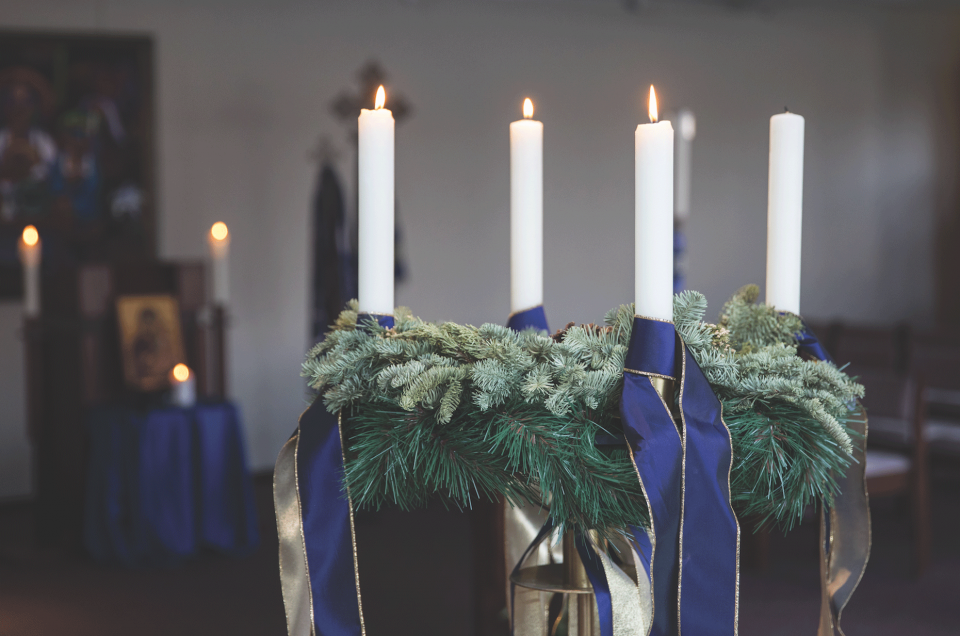Advent is a time of hoping, waiting and reflecting before Christmas. In the rush toward what is, for many, the biggest holiday of the year, sometimes we forget to take time to prepare our hearts for the birth of Jesus in our own lives. During Advent and the season of Christmas, we experience Jesus born again in us.
Advent is the church season in which we concentrate on our hope for Jesus’ renewing presence in our lives and our own readiness to welcome him into our lives and world. There is often confusion about what this season is and about its primary symbol: the Advent wreath.
Pre-Christian Germanic and Scandinavian people mounted candles on evergreen wreaths or wooden wheels to implore their gods to turn the dark season back to a time of warmth and light. As the northern Europeans became Christians, many of their prior traditions took on new meanings.
Every year as winter drew closer, Christians in northern Europe saw their days gradually shortening. Lighting the candled wreath became a symbolic resistance against the encroaching darkness. Christians proclaimed Jesus as the light of the world (John 8:12) as they witnessed the decreasing amount of daylight.
Just as the Emperor Constantine adapted the pagan Roman “birthday of the unconquered sun” on Dec. 25 to celebrate the birthday of our risen savior, unconquered by the powers of sin and death, so, too, did Germanic and Scandinavian Christians adapt the candled wreath to point to Jesus’ power over darkness in our lives. Not until 1839 did German Lutheran pastor and missionary Johann Hinrich Wichern invent the modern Advent wreath, with a fixed number of candles lit incrementally to count the days and weeks until the Christ mass.
The candles in Wichern’s wreath were white for Sundays and red for every other day of the week during Advent. Today, candle colors differ by denomination—and sometimes by congregation. As a result of liturgical reform, many ELCA congregations use blue candles, which point to Advent as a season of hope and expectation as we await our royal savior.
Other Lutherans maintain the older tradition of an Advent wreath with three purple candles and one pink candle. The purple candles point to Advent as a penitential season, like Lent, in which we prepare our hearts for our coming messiah. The pink candle is lit on Gaudete (Latin for “rejoice”) Sunday, a practice that stems from Philippians 4:4-6, which reminds us to “rejoice in the Lord always.”
Other traditions include using undyed candles, which puts the focus squarely on the light that Christ brings to the world. In every case, in the middle of the Advent wreath stands the white Christ candle, lit during the season of Christmas to remind us of Jesus’ abiding presence and light within us.
Martin Luther found the season of Advent especially useful for teaching children about Jesus’ coming into the world. An Advent wreath can be a fun, physical teaching tool to help young ones understand why we mark Advent and celebrate Christmas.
As Advent begins, I look forward to calling my sons to the window in the evenings to see how early the darkness comes. We will gather at the kitchen table and, with my baby safely in his high chair away from the flames, I’ll help my preschooler light candles. We will talk about how, just as a candle can give us light, Jesus lights our hearts and lives, even in the darkest night and even when we don’t feel loving or happy.
My boys seem to learn and remember the most from faith lessons when there is an accompanying demonstration that is concrete, unusual and fun.
If we didn’t have the Advent wreath as a powerful scholarly tool to help children understand how Jesus overpowers the darkness by sharing his light, we would have to invent something just like it. Happily, we can draw on the traditions of the saints before us. We light the Advent wreath to let our light shine before each other (Matthew 5:16) and to welcome the Advent of Jesus—the light of the world.





